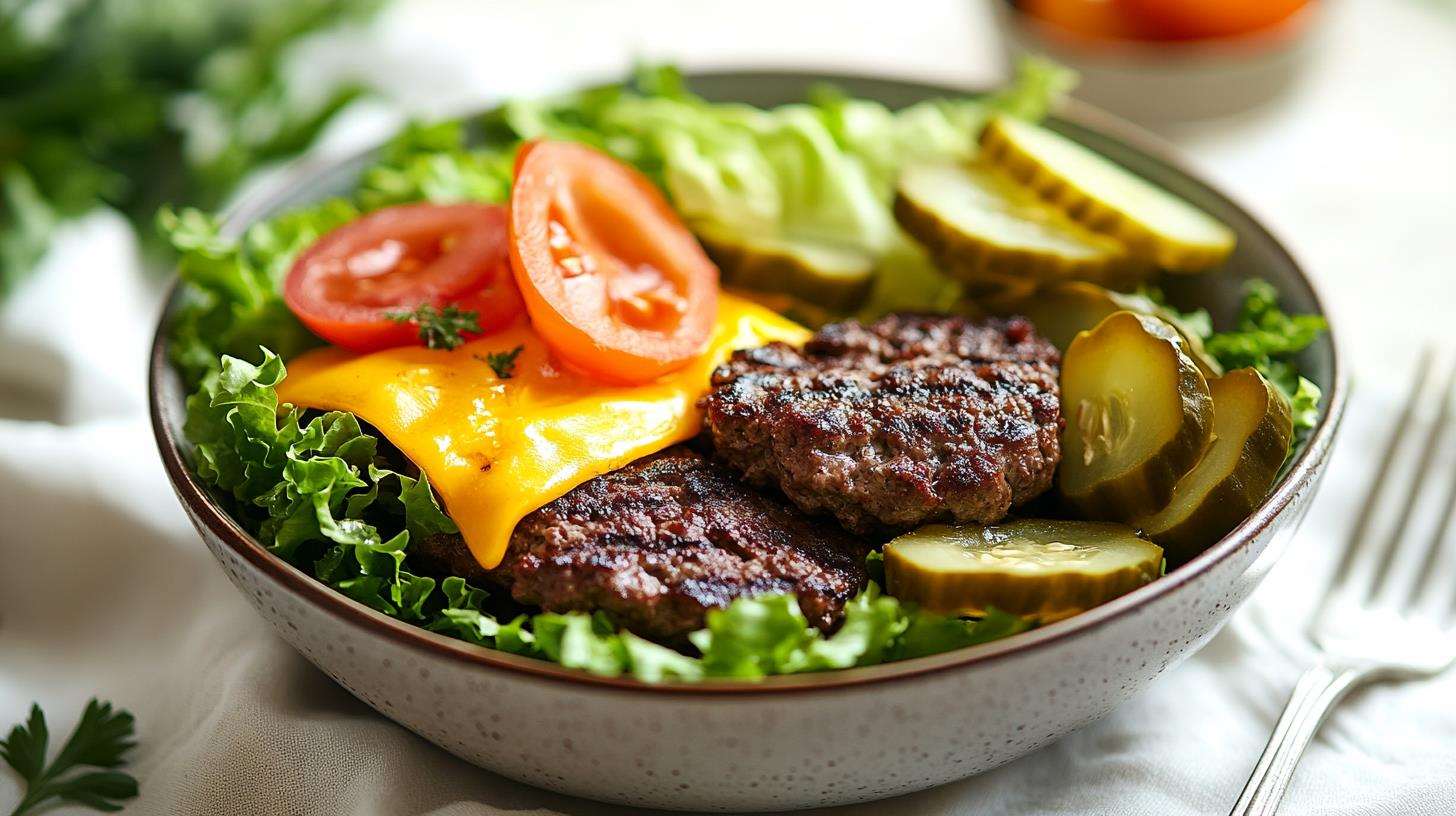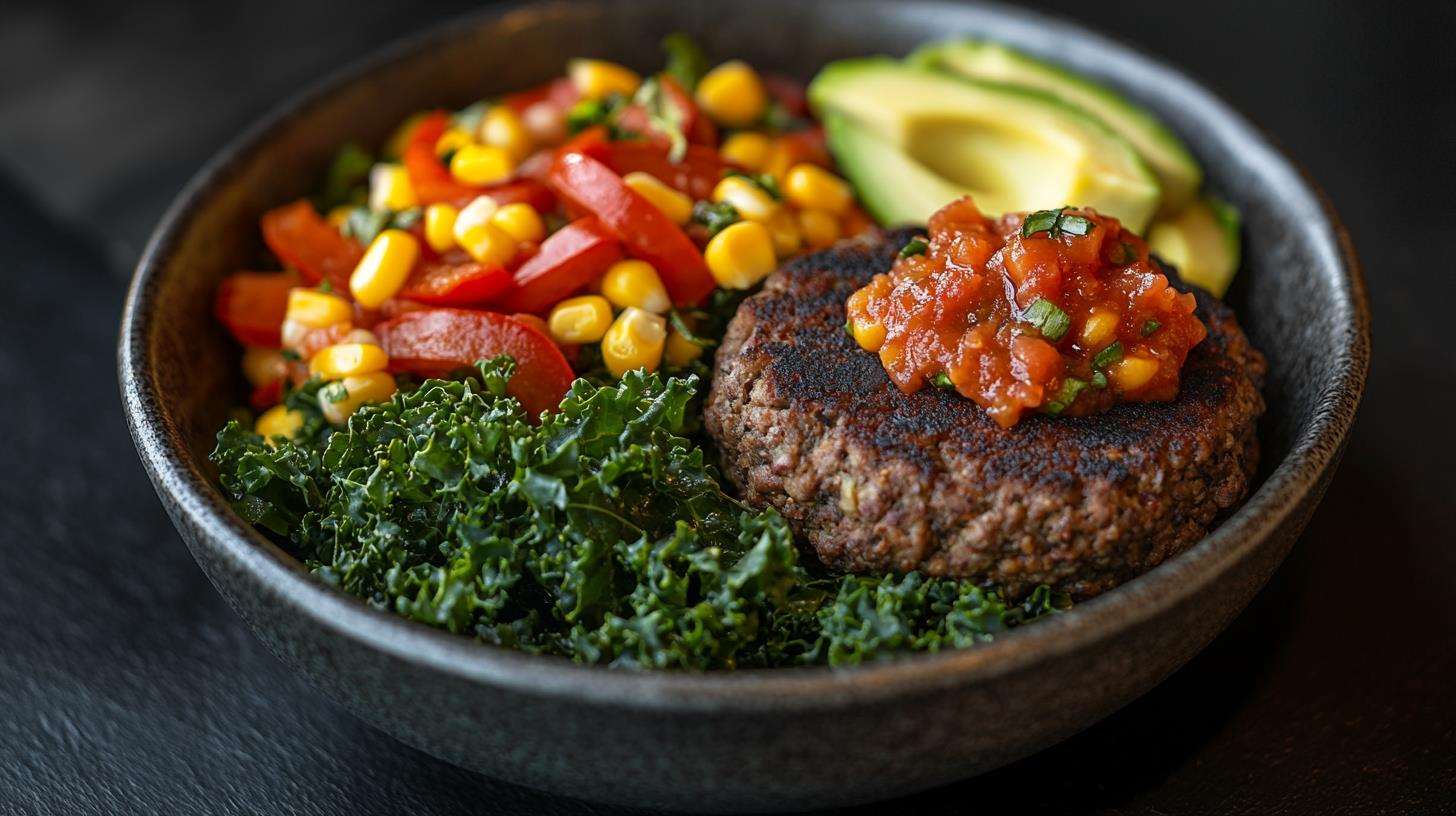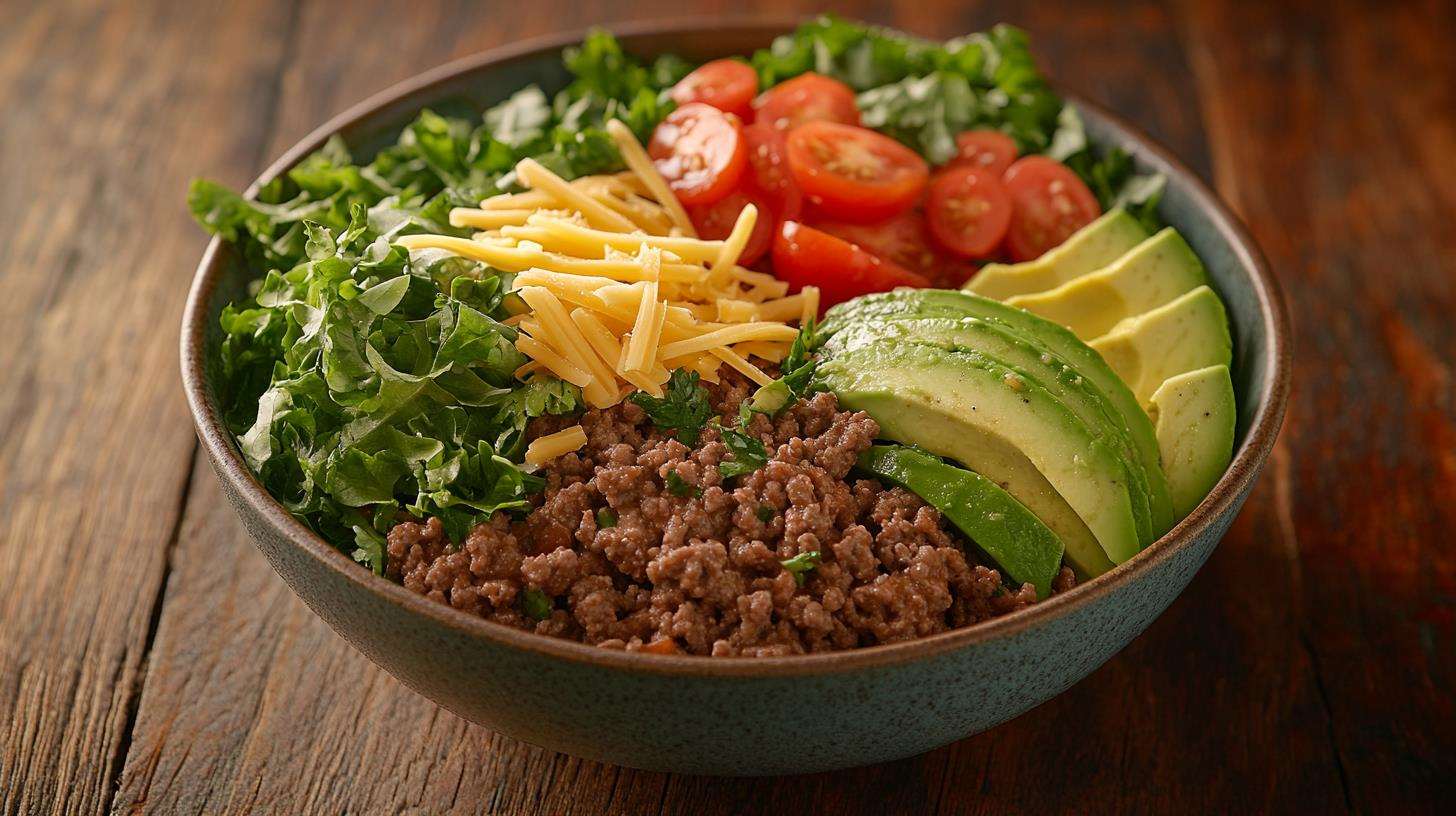If you’re a fan of burgers but looking for a healthier alternative, you’ve probably come across the concept of burger bowls. These deconstructed delights combine all the flavors of a classic burger—minus the bun—in a fresh, customizable, and often low-carb form. But the question remains: how many calories are in a burger bowl?
This comprehensive guide dives into everything you need to know about burger bowls, from calorie breakdowns to variations and nutritional benefits. Whether you’re keto-curious, a vegan foodie, or simply looking for a quick and healthy meal idea, you’ll find actionable tips and insights here. Let’s begin!
Understanding Burger Bowls
What Is a Burger Bowl?
A burger bowl is essentially a deconstructed burger served in a bowl instead of a bun. Think of it as all your favorite burger ingredients—like ground beef, cheese, lettuce, tomatoes, and pickles—layered in a fresh and colorful presentation.
Unlike traditional burgers, burger bowls are highly customizable. You can choose your protein, load up on veggies, and adjust the toppings to fit your dietary goals. This flexibility makes burger bowls an ideal choice for people following low-carb or keto diets, as well as anyone looking to reduce calories without sacrificing flavor.
Why Choose a Burger Bowl Over a Traditional Burger?
So, why skip the bun? First off, eliminating the bread significantly cuts down on carbs and calories. For instance, a standard burger bun adds about 200 calories to your meal. By opting for a burger bowl, you’re not only saving calories but also boosting the overall nutritional value by incorporating more vegetables.
Burger bowls also cater to diverse dietary needs. Whether you’re keto, paleo, vegan, or simply looking for a low-calorie alternative, you can adapt your bowl to suit your preferences. And let’s not forget the convenience factor—burger bowls are easy to prepare at home and perfect for meal prep.
Calorie Breakdown of a Classic Burger Bowl
Ingredients and Their Calorie Counts
So, how many calories are in a burger bowl? The answer largely depends on the ingredients you choose. Here’s a breakdown of typical components in a classic burger bowl:
- Ground Beef (85% lean, 15% fat): 200–300 calories per 4 oz serving.
- Cheddar Cheese: 110 calories per 1 oz slice.
- Lettuce (Romaine or mixed greens): A mere 5 calories per cup, adding crunch without the calories.
- Tomatoes: About 20 calories per half-cup serving.
- Onions: Roughly 15 calories per quarter-cup serving.
- Pickles: Just 5 calories for a few slices.
- Dressings (e.g., Ranch or Thousand Island): 80–150 calories per 2 tablespoons.
- Avocado (optional): 120 calories per half avocado.
When combined, a typical burger bowl will clock in at 400–600 calories, depending on the portion sizes and toppings. This calorie range makes burger bowls a healthier and more controlled alternative to traditional burgers.
Average Calorie Range for a Burger Bowl
For those keeping an eye on their caloric intake, the average calorie range of a burger bowl can vary:
- Low-calorie options: By swapping beef for ground turkey or grilled chicken, and replacing cheese and dressing with lighter alternatives like salsa, you can keep the calorie count below 400.
- Hearty bowls: Adding extra cheese, bacon, or creamy dressings can push the calorie count closer to 700.
With its customizable nature, the calorie count of a burger bowl is entirely in your hands. The flexibility allows you to create a meal that meets your nutritional needs without compromising on taste.
For more ideas, you can explore the Burger Bowl Recipe at PenFood for inspiration on building your perfect bowl.
Variations in Calorie Counts
Keto Burger Bowl
A keto burger bowl is a favorite for those following a high-fat, low-carb lifestyle. Here’s what it typically includes:
- Ground beef (80% lean, 20% fat): 290 calories per 4 oz serving.
- Full-fat cheddar cheese: 110 calories per slice.
- Bacon: 90 calories for 2 slices.
- Avocado: 120 calories per half avocado.
- Mayo-based dressing: 150 calories per 2 tablespoons.
With these components, a keto burger bowl can range from 600–800 calories. Despite the higher calorie count, its low-carb profile makes it a top choice for keto dieters.
Vegan Burger Bowl
For plant-based eaters, a vegan burger bowl provides a balanced and satisfying meal. Ingredients often include:
- Black bean or lentil patty: 150 calories per patty.
- Dairy-free cheese: 60 calories per slice.
- Leafy greens: 10 calories per cup.
- Salsa: 20 calories per quarter cup.
- Roasted veggies (e.g., zucchini, bell peppers): 50 calories per half cup.
- Avocado: 120 calories per half avocado.
A vegan burger bowl typically ranges from 400–500 calories and is packed with fiber and plant-based protein.
Low-Calorie Alternatives
If you’re aiming to keep your burger bowl under 400 calories, try these swaps:
- Use lean ground turkey or chicken instead of beef to save about 100 calories per serving.
- Skip the cheese or opt for a reduced-calorie variety.
- Swap heavy dressings for salsa or a splash of lemon juice.
With these simple tweaks, you can create a burger bowl that’s as light or indulgent as you want while still answering the question: how many calories are in a burger bowl?
Building Your Own Burger Bowl
Step-by-Step Guide to Customization
Crafting your own burger bowl is simple, fun, and perfect for tailoring to your taste and dietary needs. Plus, it answers the ever-popular question: how many calories are in a burger bowl? The beauty of making it yourself is full control over every ingredient.
1: Choose Your Protein
Your protein sets the tone for your burger bowl. Some great options include:
- Ground Beef: Stick with 85% lean for a balance of flavor and fat.
- Ground Turkey or Chicken: A leaner alternative to reduce calories.
- Plant-Based Patties: Opt for black bean or lentil patties to keep it vegan.
- Grilled Tofu or Tempeh: Another plant-based, protein-packed option.
2: Pick a Base
The base of your burger bowl adds volume and nutrients. Popular choices are:
- Leafy greens like romaine, spinach, or kale.
- Mixed greens for a variety of flavors and textures.
- Cooked vegetables, such as roasted zucchini or bell peppers.
3: Add Veggies
Adding veggies doesn’t just enhance flavor—it boosts the nutritional value of your bowl. Include items like:
- Tomatoes for sweetness and vitamin C.
- Cucumbers for a hydrating crunch.
- Mushrooms for a savory umami kick.
- Onions for added sharpness.
4: Include Toppings
Toppings make your burger bowl exciting. Consider options like:
- Cheese (cheddar, mozzarella, or dairy-free alternatives).
- Avocado for creaminess and healthy fats.
- Pickles or jalapeños for tang or spice.
- Bacon for a keto-friendly indulgence.
5: Dress It Up
The dressing ties everything together. Stick to portion control for calorie-dense options:
- Ranch or mayo-based dressings (use sparingly).
- Salsa or vinaigrette for lighter alternatives.
For more ideas on creating a flavorful bowl, check out this Burger Bowl Recipe at PenFood!
Tips for Meal Prep
Meal prepping burger bowls can save time and make healthy eating effortless. Here’s how to do it right:
Prepping Protein
Cook your protein in bulk—grill several patties or sauté ground meat at once. Store them in airtight containers for up to 4 days.
Prepping Veggies
Wash and chop your veggies in advance, keeping them in separate containers. Leafy greens stay fresher with a paper towel to absorb moisture.
Storing and Assembling
Keep your ingredients separate to avoid sogginess. When ready to eat, combine them in a bowl and add dressing just before serving.
Nutritional Benefits of Burger Bowl Ingredients
Protein Sources: The Powerhouse of Your Meal
Protein is the star of any burger bowl and plays a big role in its calorie content. Whether you choose ground beef, turkey, or plant-based alternatives, it provides:
- Essential amino acids to support muscle growth and repair.
- Long-lasting energy to keep you full for hours.
Veggie Additions: Adding Flavor and Fiber
Vegetables are the unsung heroes of any burger bowl. Packed with fiber, vitamins, and antioxidants, they not only make your meal colorful but also incredibly nutritious:
- Leafy Greens: Low in calories, high in vitamin C, and perfect for volume.
- Tomatoes: Bursting with antioxidants like lycopene.
- Bell Peppers: Rich in vitamin A and crunch.
Healthy Fats and Toppings
Adding healthy fats like avocado and olive oil enhances flavor while supporting brain and heart health. Cheese, in moderation, adds calcium and protein, while bacon (for keto enthusiasts) provides fat and a savory crunch.
Burger bowls aren’t just delicious; they’re a nutrient-dense way to enjoy your favorite flavors without the guilt of extra calories.
Common Mistakes to Avoid When Making Burger Bowls
Creating a burger bowl seems simple enough, but a few common mistakes can lead to an unbalanced meal or hidden calories. Let’s explore how to get it just right and answer the big question: how many calories are in a burger bowl?
Overloading on High-Calorie Ingredients
It’s easy to go overboard with calorie-dense toppings like cheese, bacon, and creamy dressings. While these ingredients are tasty, they can quickly push your burger bowl into the 800-calorie range. To keep things balanced:
- Measure your cheese and dressings. Use 1–2 tablespoons of dressing to avoid calorie overload.
- Swap full-fat cheese for a reduced-fat version or use a smaller portion.
Skipping the Vegetables
Sometimes, in an effort to focus on protein and fats, people forget to include enough vegetables. Veggies add essential nutrients and fiber, making your meal more filling without many extra calories. Load your bowl with:
- Leafy greens for a low-calorie base.
- Colorful vegetables like tomatoes, cucumbers, and bell peppers for crunch and flavor.
Ignoring Flavor Balance
A great burger bowl combines salty, tangy, creamy, and spicy elements. Ignoring this balance can make your bowl feel one-dimensional. Add variety by including:
- Pickles or a splash of vinegar for acidity.
- A dash of hot sauce or jalapeños for heat.
- Fresh herbs like parsley or cilantro for a burst of freshness.
By avoiding these pitfalls, you can ensure your burger bowl is both delicious and healthy.
FAQs About Calories in Burger Bowls
Burger bowls are versatile, but their calorie content often varies depending on ingredients. Here are answers to some frequently asked questions to help you make informed choices.
How Many Calories Are in KFC Bowls?
KFC bowls typically contain about 720 calories. Unlike burger bowls, they often include mashed potatoes, gravy, cheese, and crispy chicken, making them higher in carbs and fat.
How Many Calories Are in a Bowl of Burger Rings?
A bowl of burger rings, often considered a snack, has around 250–300 calories per serving. These fried snacks don’t offer the same nutritional benefits as a homemade burger bowl packed with fresh ingredients.
How Many Calories Are in an Average-Sized Burger?
An average burger, complete with a bun, patty, cheese, and condiments, can range from 500 to 700 calories. Swapping the bun for a salad base in a burger bowl can significantly reduce calories while maintaining flavor.
How Many Calories Are in a Large Beef Bowl?
A large beef bowl, especially one served with rice and sauce, can contain 800–1,000 calories. By skipping the rice and opting for a burger bowl instead, you can lower both the calories and carbs.
Burger bowls offer a healthier twist on a classic meal, and now you know exactly how many calories are in a burger bowl based on your ingredient choices. Whether you’re meal prepping, experimenting with flavors, or following a specific diet, these bowls are as versatile as they are delicious.
Popular Burger Bowl Recipes
When it comes to answering how many calories are in a burger bowl, specific recipes offer clear guidance. Here are a few delicious options that showcase the versatility of burger bowls.
Classic Cheeseburger Bowl

Ingredients:
- Ground beef, cheddar cheese, romaine lettuce, tomatoes, pickles, and ranch dressing.
Calorie Count: Approximately 500–600 calories per serving.
This is the go-to option for those who want the classic burger flavor without the bun. Pairing a leaner cut of beef with fresh vegetables can keep this bowl satisfying yet balanced.
Southwest Burger Bowl
Ingredients:
- Ground beef, pepper jack cheese, mixed greens, black beans, corn, bell peppers, avocado, and salsa.
Calorie Count: Approximately 550–650 calories per serving.
This variation adds a Tex-Mex twist to your burger bowl. The inclusion of black beans and corn provides fiber and a slight sweetness that balances the spice of pepper jack cheese and salsa.
BBQ Bacon Burger Bowl
Ingredients:
- Ground beef, cheddar cheese, crispy bacon, spinach, tomatoes, red onions, and BBQ sauce.
Calorie Count: Approximately 600–700 calories per serving.
The combination of smoky bacon and tangy BBQ sauce creates a bold flavor profile. Opt for turkey bacon or a lighter BBQ sauce to trim some calories if needed.
Vegan Black Bean Burger Bowl
Ingredients:
- Black bean patty, dairy-free cheese, kale, roasted bell peppers, corn, avocado, and salsa.
Calorie Count: Approximately 450–550 calories per serving.
This plant-based option delivers on both flavor and nutrition. Roasted veggies and avocado add depth and creaminess, while the black bean patty provides a solid dose of protein.

For more creative ideas, explore other customizable bowl recipes to find the perfect balance for your calorie and flavor preferences.
How Many Calories Are in a Burger Bowl? A Final Thought
By now, you’ve seen just how versatile burger bowls can be. Whether you’re aiming for a low-calorie, high-protein, or vegan-friendly meal, burger bowls adapt to nearly any lifestyle. The calorie content of a burger bowl can range widely—from as little as 400 calories for a lighter option to over 700 calories for a heartier meal.
The Appeal of Burger Bowls
Burger bowls appeal to everyone, from keto dieters to busy families looking for a quick, healthy dinner. With fresh veggies, lean proteins, and creative toppings, they’re a meal you can feel good about eating.
Building a Healthy Lifestyle
Making small swaps, like using lean proteins or skipping high-calorie dressings, can make all the difference when answering how many calories are in a burger bowl. These small changes lead to big benefits over time, helping you create meals that are as healthy as they are delicious.
Whether you’re new to burger bowls or a seasoned pro, the options are endless. Keep experimenting with ingredients to find your favorite combination, and enjoy the process of creating meals that are tailored to your goals and tastes.

